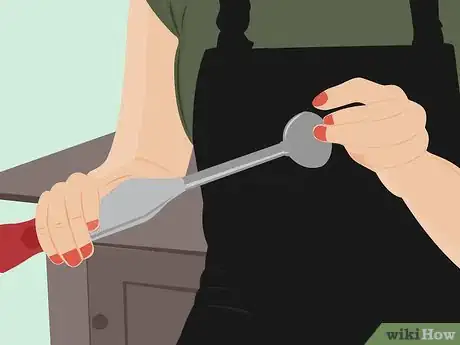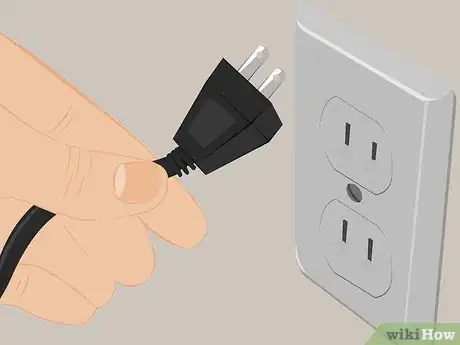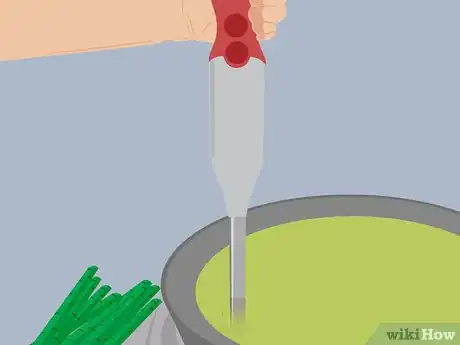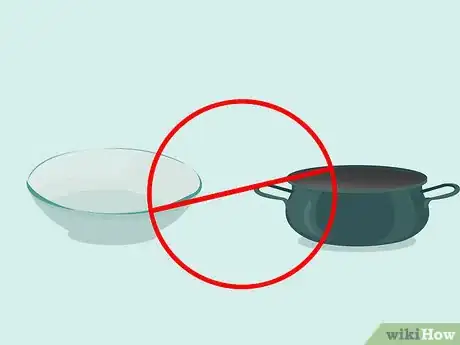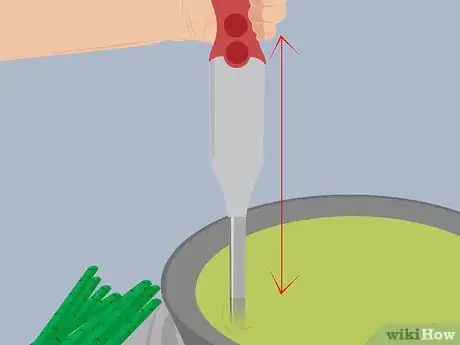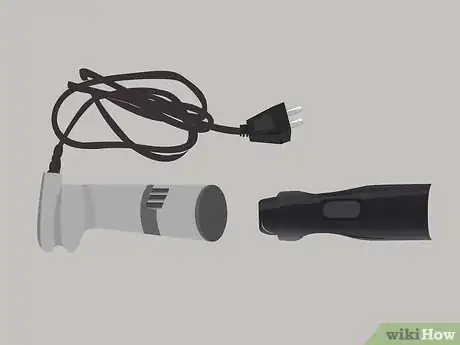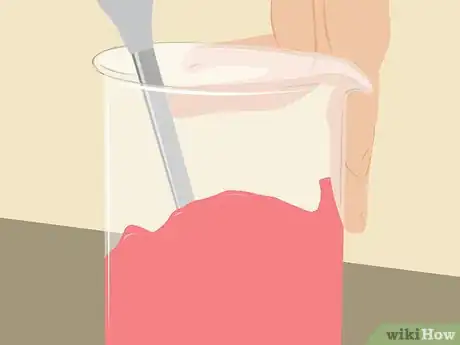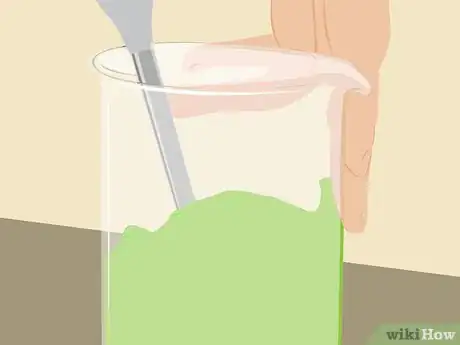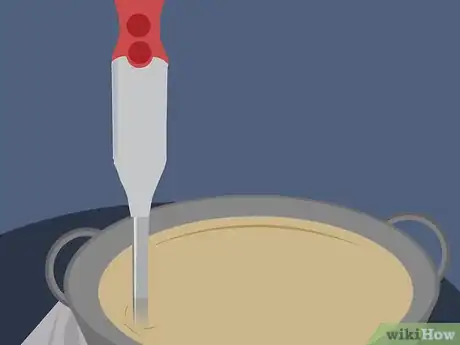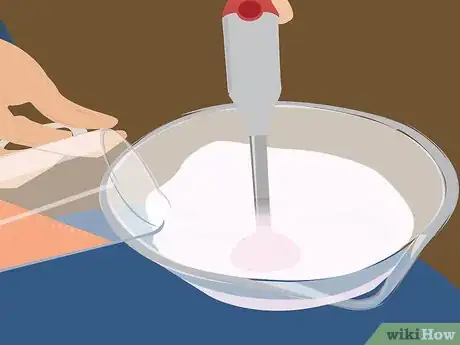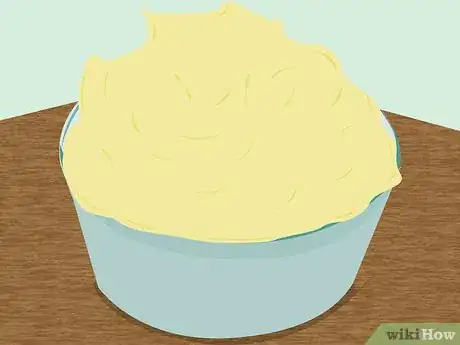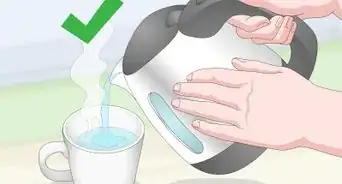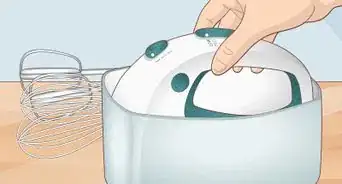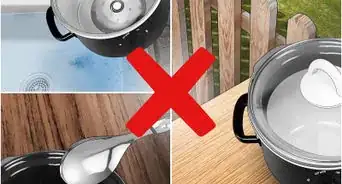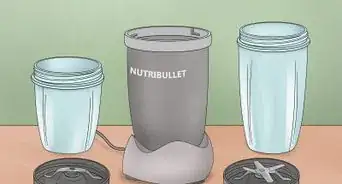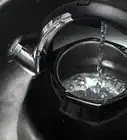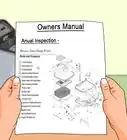This article was co-authored by wikiHow Staff. Our trained team of editors and researchers validate articles for accuracy and comprehensiveness. wikiHow's Content Management Team carefully monitors the work from our editorial staff to ensure that each article is backed by trusted research and meets our high quality standards.
There are 11 references cited in this article, which can be found at the bottom of the page.
This article has been viewed 44,462 times.
Learn more...
You may be more familiar with the immersion blender by the name of hand blender, stick blender, or wand blender, but no matter what you call it, this versatile tool is useful in the kitchen.[1] An electrified wand powers a motor to turn a rotary blade or attachment, making many common blending, mixing, and beating kitchen tasks a cinch.[2] After you learn how to operate your immersion blender, there are plenty of recipes where you can put it to use.
Steps
Operating Your Immersion Blender
-
1Assemble the blender. Depending on your model of immersion blender, this process may vary. Many immersion blenders have a spring loaded catch that clicks when component parts are fitted into place, while others may have screw-on attachments. To assemble your blender you should:
- Line up the motor body, which will be the heaviest part of the blender, with a blender attachment. Fasten these parts together securely.
- Press the release button on the motor body of the blender if the attachment doesn't connect easily.[3]
-
2Plug in its electrical cord.[4] Choose an outlet that is off to the side of your work area. The last thing you want is to sever the cord while blending and create a dangerous situation. For unmanageable or difficult cords, you may want to use a heavy item, like a bowl, to hold the cord out of the way.Advertisement
-
3Insert your blender into the mixture you will blend. Be sure the blender attachment is completely submerged in the mixture you are blending. Failing to do so could result in food being splattered all over your kitchen.[5]
-
4Blend your mixture. Flick the switch on your hand blender to activate the attachment. For many of these blenders, there is only a single speed, often indicated by the word "ON." Be sure to keep the blades of your blender below the surface of your mixture to prevent food from spattering.[6]
- When blending, move the blender slowly up and down. This will encourage a well blended, smooth consistency in your mixture.
- For tough ingredients, like vegetables, or thick mixtures, like some soups, you may have to blend for some time until the mixture is smooth and consistent.
- Running the motor of your blender for extended periods can do damage to it. Try to limit your blending to 30 to 50 second intervals.[7]
-
5Unplug the blender as soon as you finish. If the blender attachment is activated while the blender isn't immersed, it can be very dangerous. To prevent accidental harm or injury, unplug your blender as soon as you finish using it.[8]
Using Immersion Blenders Safely
-
1Avoid using non-stick pans and glass dishes. Glass can chip or shatter if it comes into contact with the blades of your blender. If this happens, you'll have to throw out your mixture, otherwise you could ingest glass, which can be deadly. The non-stick coatings on pans, too, can chip off into your mixture. This coating can be unhealthy if ingested.
- The safest kind of mixing container for you to use with your immersion blender will be stainless steel.[9]
-
2Keep your the blender motor above all liquid when blending. By lowering the motor of your immersion blender into your mixture, you could cause the motor to burn out, the electrical components to short out, or you could potentially electrocute yourself. Even with especially deep dishes, refrain from lowering the motor into or beneath your mixture.[10]
-
3Unplug the blender when cleaning. Always unplug your blender before cleaning it. Never immerse the motor of your blender in water when cleaning, but you can clean it with mild soap and a sponge or damp cloth. The blending shaft should be washed by hand in hot water and should also be cleaned with a mild soap.
- When cleaning the blending shaft, be extra careful around the blades. These are very sharp, and can cut you easily.[11]
-
4Store your immersion blender in a safe location. Immersion blenders are simple enough for children to use, and may be confused for a toy. This can be very dangerous, so you should store your blender in safe locations that are difficult for children to access, like in a high cupboard.[12]
Making Recipes with Your Immersion Blender
-
1Blend up some salsa. If you're not a fan of chunky salsa, your immersion blender can make a smooth version in a jiffy. Add tomatoes, onion, garlic, jalapeño, cilantro, and a little bit of salt and pepper to a tall, narrow stainless steel dish. Then move your immersion blender up and down until your ingredients are blended to your preference.
- Depending on your tastes, you'll have to determine how much of each ingredient to use. For example, if you like spicier salsa, you might want to add more jalapeño to the mix.
- You may want to add your tomatoes last to your mixing dish. This way, they'll be at the top and blend first. This will release liquid that will help blend the other ingredients.
- Keep your blender level when operating. Even in your mixing dish, tilting your blender on too much of an angle can cause foot to spatter and fly.[13]
-
2Whip up a pesto sauce, presto.[14] Add basil, garlic, pine nuts, olive oil, and a little salt and pepper to a tall, narrow stainless steel mixing dish. Keep the blades of your blender level, and with an up-and-down motion, blend together the ingredients to make your pesto.[15]
- A simple pesto recipe you might use: 2 cups packed with fresh basil leaves, 2 full cloves of garlic, ¼ cup of pine nuts, 2/3 of a cup of extra-virgin olive oil.[16]
-
3
-
4Create smoothies in small batches. Making a smoothie in a full sized blender can result in more smoothie than one person can drink along with a considerable mess.[19] Add frozen fruit, some yogurt, and enough juice to cover all the ingredients to a tall, narrow stainless steel mixing dish. Then, use your blender to mix all ingredients thoroughly.[20]
-
5Blend up homemade mayonnaise. This normally time consuming activity can be ready in as few as five minutes when using an immersion blender. Add 2 egg yolks, 1 tsp lemon juice, ½ tsp salt, and ½ tsp dry mustard to a tall, narrow stainless steel mixing dish. Use your blender to combine these ingredients. Then add 1 cup of olive/canola oil a little bit at a time to the mixture while running your blender.
- Wait until added oil disappears completely before adding more oil to the mixture. As oil is absorbed, it will add to the mixture more easily. Once you've added half a cup of oil, you can add the remaining half in a steady stream.
- If the mayo turns out too thick for your liking, use your blender to mix in water 1 tsp at a time until you achieve your preferred consistency.[21]
Warnings
- Exercise caution whenever operating your immersion blender. Its blades can be very sharp, and can cut you even when the blender is unplugged.⧼thumbs_response⧽
References
- ↑ http://www.lifeasastrawberry.com/10-ways-to-use-your-immersion-blender/
- ↑ https://www.thecitycook.com/articles/2011-09-29-the-essential-kitchen-immersion-blenders
- ↑ https://s3.amazonaws.com/szmanuals/c8114b0cbfc4ce89394ea8e21f9492bd
- ↑ https://s3.amazonaws.com/szmanuals/c8114b0cbfc4ce89394ea8e21f9492bd
- ↑ http://www.bonappetit.com/test-kitchen/tools-test-kitchen/article/blender-food-processor
- ↑ https://www.thecitycook.com/articles/2011-09-29-the-essential-kitchen-immersion-blenders
- ↑ https://s3.amazonaws.com/szmanuals/c8114b0cbfc4ce89394ea8e21f9492bd
- ↑ https://s3.amazonaws.com/szmanuals/c8114b0cbfc4ce89394ea8e21f9492bd
- ↑ https://www.cuisinart.com/share/pdf/manuals/csb-79.pdf
- ↑ https://www.cuisinart.com/share/pdf/manuals/csb-79.pdf
- ↑ https://s3.amazonaws.com/szmanuals/c8114b0cbfc4ce89394ea8e21f9492bd
- ↑ http://www.nytimes.com/2013/01/16/dining/immersion-blenders-can-be-a-danger-in-disguise.html
- ↑ http://www.lifeasastrawberry.com/10-ways-to-use-your-immersion-blender/
- ↑ http://www.huffingtonpost.com/2012/08/03/immersion-blender-uses_n_1734037.html?slideshow=true#gallery/242418/6
- ↑ http://www.lifeasastrawberry.com/10-ways-to-use-your-immersion-blender/
- ↑ http://www.foodnetwork.com/recipes/food-network-kitchens/basil-pesto-recipe2.html
- ↑ http://www.thekitchn.com/10-smart-ways-you-should-be-using-your-immersion-blender-225204
- ↑ http://www.lifeasastrawberry.com/10-ways-to-use-your-immersion-blender/
- ↑ http://www.huffingtonpost.com/2012/08/03/immersion-blender-uses_n_1734037.html?slideshow=true#gallery/242418/8
- ↑ http://www.lifeasastrawberry.com/10-ways-to-use-your-immersion-blender/
- ↑ http://www.thekitchn.com/how-to-make-mayonnaise-with-an-immersion-blender-cooking-lessons-from-the-kitchn-206496
